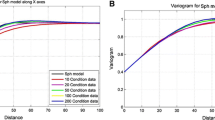Abstract
The modelling of spatial uncertainty in attributes of geological phenomena is frequently based on the stochastic simulation of Gaussian random fields. This paper presents a generalization of the sequential Gaussian simulation method founded upon the group decomposition of the posterior probability density function of a stationary and ergodic Gaussian random field into posterior probability densities of a set of groups of nodes of size ν. The method, which is termed “generalized sequential Gaussian simulation on group size ν,” relies computationally on sharing the neighborhood of adjacent nodes and simulates groups of ν nodes at a time, instead of the traditional node-by-node simulation. The new method is computationally efficient and suitable for simulation on large grids of nodes. Results suggest that, in terms of computing cost (time), an optimal size ν of a group is about 80% of the optimal neighborhood used for sequential Gaussian simulation and that computation can be up to 50 times faster than the regular sequential Gaussian method, with little loss in accuracy. The effectiveness of the method is assessed by using a general measure of accuracy, “screen-effect approximation loss” (SEA loss), defined herein as the mean-square difference between the simulated value posterior to the information in the neighborhood and the simulated value posterior to all information, and shown to be determined by the corresponding posterior variances. The results presented show that both the exponential and the spherical models perform well and can meet the less-than 5% relative SEA loss requirement for any grid setup using a relatively small neighborhood. The Gaussian covariance model was found to have a relatively high relative SEA loss in most cases.
Similar content being viewed by others
REFERENCES
Alabert, F., 1987, Stochastic imaging of spatial distributions using hard and soft information: Unpublished MSc thesis, Stanford University, Stanford, CA, 197 p.
Berger, J. O., 1985, Statistical decision theory and Bayesian analysis: Springer-Verlag, New York, 617 p.
Cormen, T. H., Leiserson, C. E., and Rivest, R. L., 1990, Introduction to algorithms: The MIT Press, Cambridge, MA, 1028 p.
David, M., 1977, Geostatistical ore reserve estimation: Elsevier, Amsterdam, 364 p.
Davis, M. W., 1987a, Production of conditional simulations via the LU triangular decomposition of the covariance matrix: Math. Geol., v. 19, no. 2, p. 91–98.
Davis, M. W., 1987b, Generating large stochastic simulation-The matrix polynomial approximation method: Math. Geol., v. 19, no. 2, p. 99–107.
Dietrich, C. R., and Newsam, G. N., 1996, Fast and exact method for multidimensional Gaussian stochastic simulations: Extension to conditional simulations: Water Resour. Res., v. 32, no. 6, p. 1643–1652.
Dowd, P. A., and Saraç, C., 1994, An extension of the LU decomposition method of simulation, inArmstrong, M., and Dowd, P.A., eds., Geostatistical simulations: Kluwer, Dordrecht, p. 23–36.
Godoy, M., 2003, The effective management of geological risk in long-term production scheduling of open pit mines: Unpublished PhD thesis, The University of Queensland, Brisbane, Qld., 256 p.
Isaaks, E. H., 1990, The application of Monte Carlo methods to the analysis of spatially correlated data: Unpublished PhD thesis, Stanford University, Stanford, CA, 213 p.
Johnson, M., 1987, Multivariate statistical simulation: Wiley, New York, 212 p.
Journel, A.G., 1994, Modeling uncertainty: Some conceptual thoughts, inDimitrakopoulos R., ed., Geostatistics for the next century: Kluwer, Dordrecht, p. 30–43.
Luo, X., 1998, Spatiotemporal stochastic models for earth science and engineering applications: Unpublished PhD thesis, McGill University, Montreal, 177 p.
Omre, H., Solna, K., and Tjelmeland, H., 1993, Simulation of random functions on large lattices, inSoares, A., ed., Geostatistics Troia '92: Kluwer Acrs, Dordrecht, p. 179–199.
Ravenscroft, P. J., 1994, Conditional simulation for mining: Practical implementation in an industrial environment, inArmstrong, M., and Dowd, P. A., eds., Geostatistical simulations: Kluwers, Dordrecht, p. 79–87.
Ripley, B. D., 1987, Stochastic simulations: Wiley, New York, 214 p.
Rossenblatt, M., 1952, Remarks on multivariate transformation: Ann. Math. Stat., v. 23, p. 470–472.
Rubinstein, R. Y., 1981, Simulation and the Monte Carlo method: Wiley, New York, 278 p.
Scheuer, E. M., and Stoller, D. S., 1962, On the generation of normal random vectors: Technometrics, v. 4, p. 278–281.
Steinberg, D., 1974, Computational matrix algebra: McGraw-Hill, New York, 280 p.
Author information
Authors and Affiliations
Rights and permissions
About this article
Cite this article
Dimitrakopoulos, R., Luo, X. Generalized Sequential Gaussian Simulation on Group Size ν and Screen-Effect Approximations for Large Field Simulations. Mathematical Geology 36, 567–591 (2004). https://doi.org/10.1023/B:MATG.0000037737.11615.df
Issue Date:
DOI: https://doi.org/10.1023/B:MATG.0000037737.11615.df




